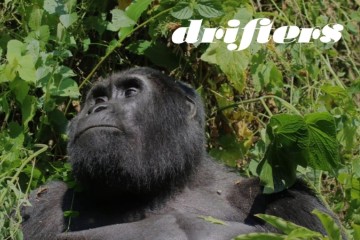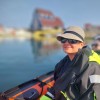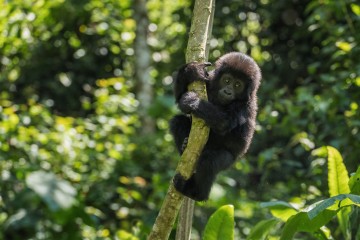Gorilla trekking is one of the world’s most extraordinary wildlife experiences and undeniably one of the most coveted adventures on Africa tours. Coming face to face with the largest primates on earth is an exhilarating, humbling and even life-changing experience, especially for wildlife enthusiasts who've been dreaming of the encounter for years. Yet, in this day and age, much consideration is also given to the ethical and conservational aspect of hiking dense primary forests in search of one of the most endangered creatures on our planet. Many potential trekkers also wonder how safe it is to track gorillas in some of Africa’s most impenetrable forests.
We can certainly understand the concern. There’s a lot to care about!
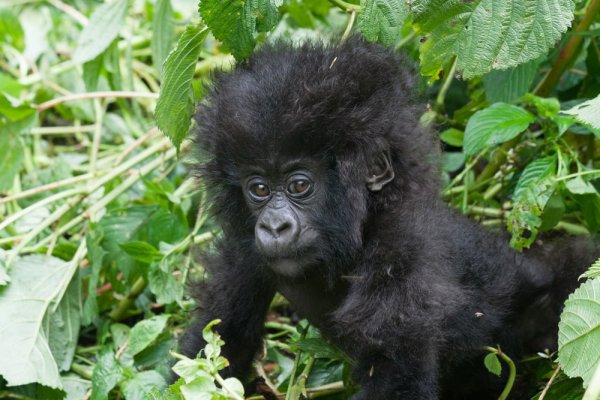
A baby mountain gorilla in the Volcanoes National Park Rwanda
Our comprehensive guide to gorilla trekking covers all you need to know about planning the ultimate wildlife adventure trip in Africa – we’ll compare treks in Uganda and Rwanda, discuss the intricacies of conservation efforts (and how your trek can help) and offer answers to some of the most common gorilla trekking questions in regards to safety and ethics.
Here’s all we’ll cover in this comprehensive gorilla trekking guide:
Is Gorilla Trekking Safe?
Gorilla trekking is considered very safe when done with the guidance of a reputable and experienced guide. The trek itself can be physically demanding and is taken over dense and uneven terrain, yet with a guide at the helm, you'll be kept safely on the right track. Guides are also essential because they are experienced wildlife experts – they'll give you a thorough rundown of what to do and how to behave once you actually come face to face with the giants of the forests.
Gorillas are not inherently predatory or aggressive animals. Plus, the ones you will meet will have gone through a 'habituation' process, so they are somewhat used to (calm and quiet) human company. We'll explain more about gorilla habituation further on in the guide.
Gorillas can be defensive, however, especially around their babies. If you follow safety protocols, you will have a perfectly safe and enjoyable experience.
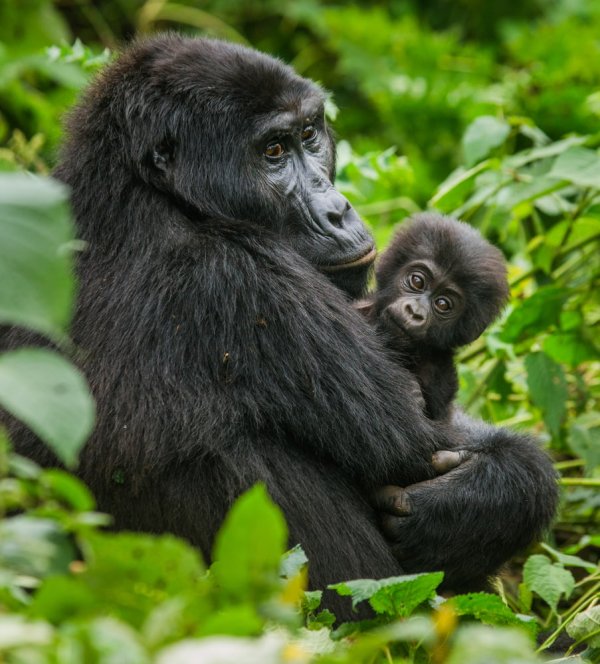
Gorillas are normally quite relaxed around humans yet take extra care when you see one with a baby
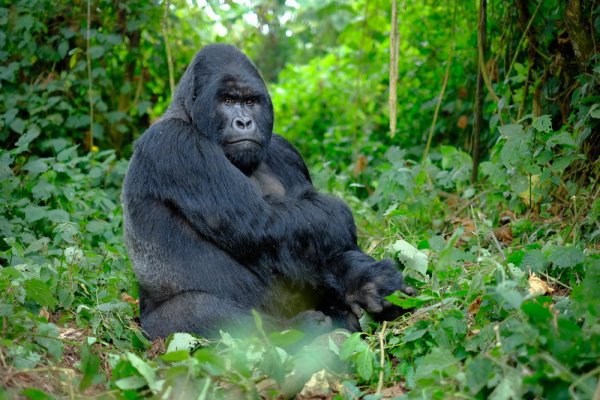
The average adult silverback can weigh 180kgs and stand 1.7m tall - keeping a safe distance is a very good idea
Is Gorilla Trekking Difficult?
As we love to tell our clients, "It is not a walk in the park…it is a trek in a dense forest’! Yes, gorilla trekking can be difficult for some, depending on the destination to choose. If you are unsure how you'd cope on a long(ish) hike through dense, uneven (and sometimes steep) terrain, improving your fitness level before heading on your Africa tour won't hurt.
Usually, trekking to spot gorillas in the Volcanoes National Park in Rwanda is an easier affair yet, sometimes, gorilla families move to higher altitudes. This can be more physically demanding on trekkers. Weather can also play a role in a trek's difficulty – the luscious forests of Africa receive plentiful rain, which can make trails muddy and slippery. At lower elevations, tropical heat can also exhaust you faster than usual.
You can do a few things to make gorilla trekking easier, including wearing the proper clothing and shoes and ensuring you are well-hydrated. We'll cover more about what to wear on a gorilla trek.
Remember that on an organized gorilla trek, you can trek at a comfortable pace and take plenty of breaks if needed. Tell your guide if you need a slower pace or more breaks, and they'll be happy to oblige – their job is to get you face-to-face with gorillas, so they'll go out of their way to ensure that happens.
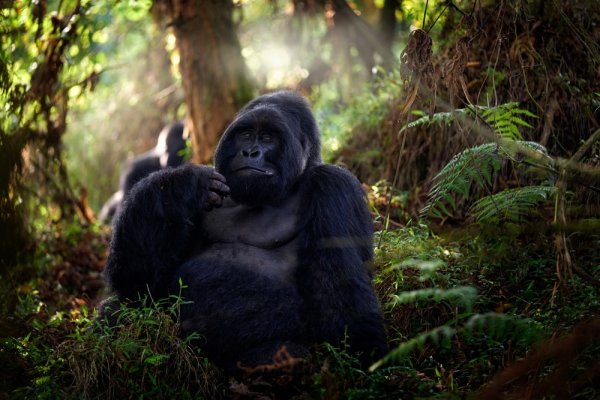
A little hard work is worth its weight in gold – Mgahinga National Park, Uganda
Is Gorilla Trekking Ethical?
It certainly can be when the well-being of the gorillas, the preservation of their natural habitat, and their neighbouring communities take top priority. That's what our gorilla trekking tours are all about.
Ethical gorilla trekking contributes to the conservation of gorillas and their habitats. Fees from permits fund conservation initiatives and support anti-poaching efforts – they pay for park guardians and fund awareness campaigns highlighting gorilla conservation's importance.
All national parks inhabited by gorillas employ an array of guidelines for trekking tours, including limiting the number of daily visitors (by issuing pre-booked permits), ensuring everyone maintains a safe viewing distance and keeping the environment pristine. Health protocols also dictate that you cannot hike if you suddenly fall ill – so keep this in mind. The well-being of the gorillas is of utmost priority.
Local communities also benefit from ethical gorilla treks – sustainable tourism in gorilla-inhabited regions offers employment opportunities for locals and helps improve local infrastructure. Aside from guides, trekkers also need hotels, restaurants, taxis and many other services. All of this helps promote sustainable livelihoods for locals.
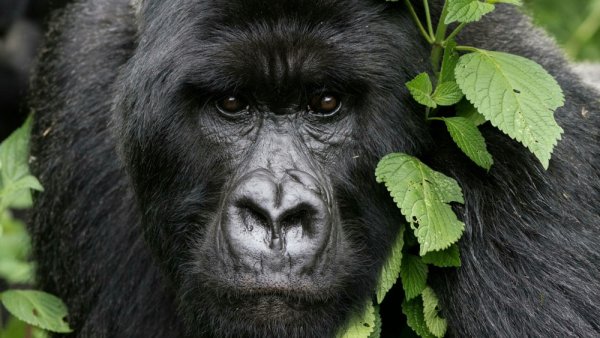
Beautiful close up of a mountain gorilla – only around 1,060 of these extraordinary creatures are left in the wild.
How Much Does a Gorilla Trekking Permit Cost?
Gorilla trekking permit costs vary by country and park. In Rwanda's Volcanoes National Park, permits are US$1,500 per person in 2023. In Uganda's Bwindi Impenetrable Forest and Mgahinga Gorilla National Parks, permits cost around US$750 for foreign tourists. Gorilla trekking permit fees include a one-hour encounter with one family of gorillas, irrespective of how long you must trek to find them.
Given the limit on permits on any given day, they normally sell out months in advance. This is particularly true in the driest months of the year (Dec, Jan, Feb, Jun, July, Aug & Sept) when trekking is much easier so tourist numbers swell.
On our Uganda Wildlife Explore Small Group Tour, we include two full days for gorilla trekking in our itinerary to ensure all our guests enjoy their allocated hour with gorillas in the wild. Since we are talking about wild animals in wild landscapes, we will never know for sure when you might encounter a family of gorillas. But we know that once you do, a one-hour limit is imposed. After an hour, your guide will move you on. The time and visitor limits ensure the gorillas receive minimal human contact during the day and have plenty more time to get on with the more important task of being a gorilla in the wild.
There is another permit available if you wish to spend more time in the company of gorillas in the wild: a gorilla habituation permit. These are unique permits only offered on specific tours. Keep reading to find out more.
Gorilla habituation permits (Uganda only)
Gorilla habituation is all about familiarizing wild gorillas with the presence of humans. This essential process, adopted only in Uganda for now, has proven vital for developing sustainable gorilla tourism. Special permits allow you to enjoy the company of gorillas for up to four hours, rather than the one-hour offered by regular gorilla trekking permits.
In 2023, gorilla habituation permits in Uganda cost around USD 1,500.
See Viva’s Ultimate Gorilla Encounter in Uganda - an extraordinary 5-day immersive adventure with a gorilla habituation experience.
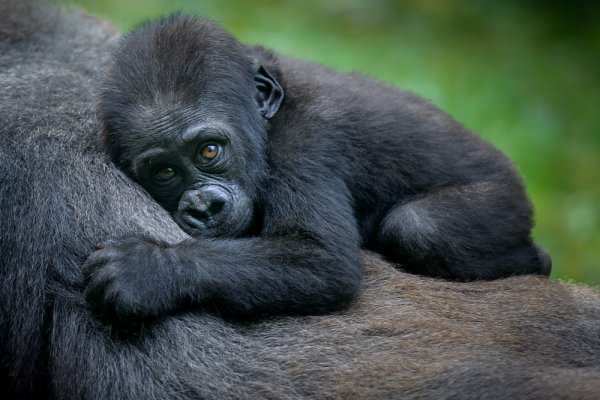
Thanks to conservation efforts over the last few decades, the number of mountain gorillas is slowly increasing. Their biggest threats are deforestation and political instability
What to Wear on a Gorilla Trek
Packing for a gorilla trek is no different from packing for any adventurous hike.
Here’s what to wear:
-
Sturdy and comfortable waterproof hiking boots with good ankle support. Ensure they are well worn in – the last thing you need on a gorilla trek is a blister!
-
Appropriate clothing for the environment (warmer for higher altitudes and thinner for rainforest treks). Opt for long trousers and long-sleeved shirts to protect against nettles, insects, and scratches, and choose lightweight, moisture-wicking, and breathable materials. Neutral colours that blend with the surroundings are best.
-
A hat – to protect you from sunburn and any falling branches/insects.
-
Always pack a waterproof jacket, gloves to grip branches/vegetation (lightweight hiking or even gardening gloves) and insect repellent.
Dehydration on gorilla treks is a common issue, so ensure you have enough drinking water. Pack some snacks, but ask permission from your guide whenever you wish to munch on anything in the forest. You might also want to pack a pair of binoculars along with your camera equipment, a plastic bag to carry your rubbish, and a small and compact daypack to carry all your gear.
Your guide will likely set a comfortable pace to keep you all safe and happy – just follow their advice, watch your step and have a fantastic time!
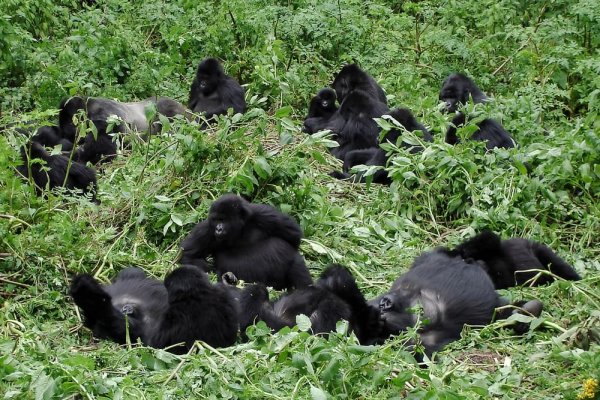
Like humans, gorillas are highly sociable animals. They live in family groups of up to 10 individuals, comprising one adult male, several adult females and their offspring.
Gorilla Trekking Tours in Uganda VS Rwanda – Which One’s Best?
The first thing you may have noticed in the section above is that gorilla trekking permits cost twice as much in Rwanda as in Uganda. Aside from the price, various factors differentiate Africa’s two most popular gorilla trekking destinations.
To start with, Rwanda’s Volcanoes boasts 12 gorilla families you can track, while Uganda’s Mgahinga hosts one solitary family and Bwindi, the most popular park for gorilla trekking, is home to 20 distinct gorilla families. Both countries allow a maximum of eight (8) people per trekking group.
Gorilla trekking in Rwanda
Rwanda is known as the more accessible, better organized and generally ‘easier’ gorilla trekking destination in Africa. Rwanda also offers more upscale accommodation options so it’s generally favoured by those seeking a more comfortable trekking experience. The country has invested significantly in developing high-end lodges and eco-friendly hotels near the park where gorilla trekking takes place.
The #1 gorilla trekking destination in Rwanda is the Volcanoes National Park, home to several gorilla families who are well used to human visitors.
Although gorillas can be found at higher altitudes at times, Volcanoes is typically a much easier park to trek when compared with Uganda's options – treks are not only easier but also shorter. The mountainous park is about 80km from the country's capital, Kigali, making it a convenient destination for fly-in/fly-out visitors on shorter vacations.
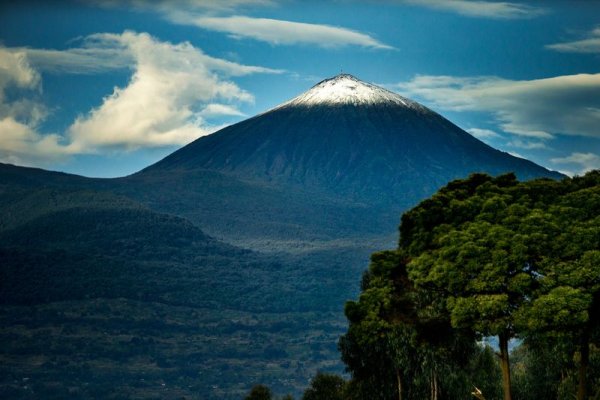
The spellbinding landscapes of the Volcanoes National Park
Rwanda offers a discount on gorilla trekking permits if combined with a chimpanzee trekking permit at Nungwe National Park. This spectacular reserve is the oldest rainforest in Africa and is home to over a dozen species of primates - most notably, chimpanzees. If you meet the right criteria (combine both parks and visit Jan-May and Nov-Dec), then the gorilla encounter permit is reduced to US$1,050.
You can see how we combine both parks on a 6-day Chimp and Gorilla Encounter Tour

Gorilla trekking in Uganda
Uganda offers more budget-friendly gorilla trekking options and two distinct national parks from which to choose: Bwindi Impenetrable Forest and Mgahinga Gorilla National Park. Both offer outstanding trekking through luscious rainforests.
The ecosystems here are distinct from Rwanda's Volcanoes National Park: the former overlooks the spectacular Virunga mountains while, in Uganda, it’s all about luscious, dense, tropical rainforest. At times, the hikes can be more strenuous here.
Both of Uganda’s gorilla parks are easily accessible by road but require long drives over bumpy roads. Great if you have more time and prefer an overland adventure. An increase in internal flights is also making Uganda a good option for shorter breaks.
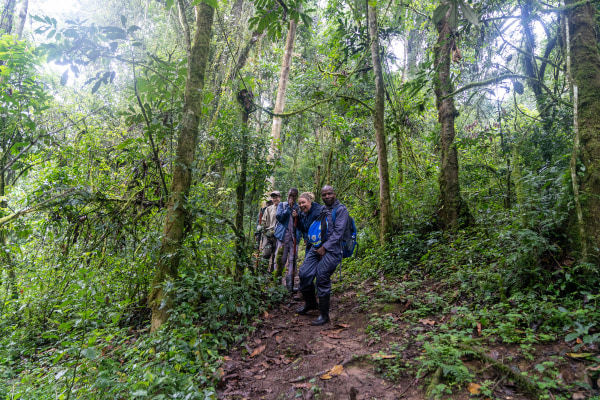
The verdant tropical wilderness of Bwindi Impenetrable Forest
Ultimately, the choice between Uganda and Rwanda for gorilla trekking will come down to your preferences, budget, travel style, and any other destinations in Africa you’re keen to visit. Both countries offer a once-in-a-lifetime chance to witness these magnificent animals in their natural habitat, and either destination can provide an utterly unforgettable adventure.

Viva’s Destination Specialists are here to help you plan the gorilla trekking adventure of your dreams. Still not sure where to go? Speak to the experts and we’ll help you figure it out!
Laura Pattara
Laura Pattara has guided overland trips across Africa and now focuses her writing on the continent for Viva Expeditions. She once camped beneath a marula tree that an elephant tore apart during the night, yet somehow she still sleeps best in a tent. But make it glam! From sunrise balloon rides over the Serengeti to following the rhythms of wildlife migrations, Laura brings the wild heart of Africa to life with warmth, depth, and the occasional muddy boot.
|
